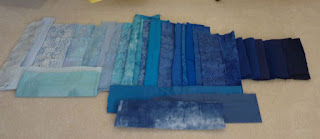You might recall back in January I decided to set some new goals for 2011.
Goals are to: Sign up for quilting swaps (possibly found online), to participate in quilt a-longs (possibly found online) or w/ guilds and to enter quilt challenges.
I was excited because the timing seemed perfect. Seeing the challenge was to create a monochromatic quilt also worked well with another goal of mine; to use from my stash as much as possible. My first step was to look through my stash to try to decide on a color, this could prove difficult since I’ve never met a color I don’t enjoy. Since Jan–March can sometimes be a rough time of the year due to seasonal snow storms it made me think of blue. Blue would be my choice, I would call it Winter Blues.
Once my color choice was made; it was now time to begin the challenge.
I gathered blues from my stash placing them in piles by value sorting out blues I felt did not seem to fit. I left the blues sitting spread out in a row for about a week weeding to and from the stack while I let my thoughts go to brainstorming a design. Traditional log cabin popped in and out along with other traditional patterns but in the end I decided to just gather my fabrics, cut some selvage to selvage strips and begin to sew them together into groups of 3 or 4 usually groups of dark and light value along with wide and thin strips.
After ironing the strips (new fabrics) I cut them up into various size shapes (rectangles and squares) and began a composition on my design wall.
After piecing the main rectangle design together I decided to complet the quilt top by adding a border. The border of my quilt was the toughest design step for me, it took the longest for me to create. I seemed to have a problem with overkill ;-)
 |
| Can you say OVERKILL? |
in the end after stepping away from my quilt for a few days I came up with a solution I felt worked for a border.
I did post some photos back when I was working on the project, yet did not explain the quilt or why I had chosen to create a monochromatic quilt. I then realized I probably should NOT be posting or share my entry till After the challenge deadline had passed.
I completed the quilt and sent it off as entry. Just this past week I've noticed at least one other quilter blogging about their entry so figure it might be okay to now share my entry completed for The Modern Quilt Guild Challenge Two - 'my first online challenge' "Winter Blues" Quilt.
 |
| My completed monochromatic quilt "Winter Blues" |
 |
| close up of Winter Blues |
I am happy with my monochromatic quilt “Winter Blues” AND I look forward to attempting more challenges in the future.
I also can't wait to view all the entries when they are posted to see the many ways 'we quilters' deciphered make a quilt that is monochromatic. ;-)


































